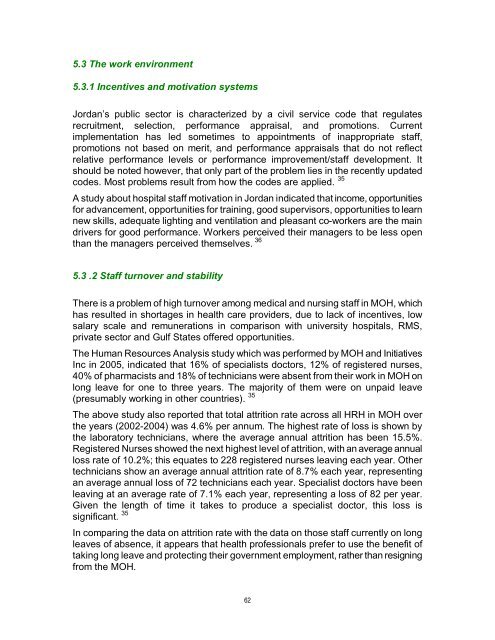Prepared by: Dr. Musa Ajlouni January, 2010 - World Health ...
Prepared by: Dr. Musa Ajlouni January, 2010 - World Health ...
Prepared by: Dr. Musa Ajlouni January, 2010 - World Health ...
Create successful ePaper yourself
Turn your PDF publications into a flip-book with our unique Google optimized e-Paper software.
5.3 The work environment5.3.1 Incentives and motivation systemsJordan’s public sector is characterized <strong>by</strong> a civil service code that regulatesrecruitment, selection, performance appraisal, and promotions. Currentimplementation has led sometimes to appointments of inappropriate staff,promotions not based on merit, and performance appraisals that do not reflectrelative performance levels or performance improvement/staff development. Itshould be noted however, that only part of the problem lies in the recently updatedcodes. Most problems result from how the codes are applied. 35A study about hospital staff motivation in Jordan indicated that income, opportunitiesfor advancement, opportunities for training, good supervisors, opportunities to learnnew skills, adequate lighting and ventilation and pleasant co-workers are the maindrivers for good performance. Workers perceived their managers to be less openthan the managers perceived themselves. 365.3 .2 Staff turnover and stabilityThere is a problem of high turnover among medical and nursing staff in MOH, whichhas resulted in shortages in health care providers, due to lack of incentives, lowsalary scale and remunerations in comparison with university hospitals, RMS,private sector and Gulf States offered opportunities.The Human Resources Analysis study which was performed <strong>by</strong> MOH and InitiativesInc in 2005, indicated that 16% of specialists doctors, 12% of registered nurses,40% of pharmacists and 18% of technicians were absent from their work in MOH onlong leave for one to three years. The majority of them were on unpaid leave(presumably working in other countries). 35The above study also reported that total attrition rate across all HRH in MOH overthe years (2002-2004) was 4.6% per annum. The highest rate of loss is shown <strong>by</strong>the laboratory technicians, where the average annual attrition has been 15.5%.Registered Nurses showed the next highest level of attrition, with an average annualloss rate of 10.2%; this equates to 228 registered nurses leaving each year. Othertechnicians show an average annual attrition rate of 8.7% each year, representingan average annual loss of 72 technicians each year. Specialist doctors have beenleaving at an average rate of 7.1% each year, representing a loss of 82 per year.Given the length of time it takes to produce a specialist doctor, this loss issignificant. 35In comparing the data on attrition rate with the data on those staff currently on longleaves of absence, it appears that health professionals prefer to use the benefit oftaking long leave and protecting their government employment, rather than resigningfrom the MOH.62

















